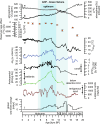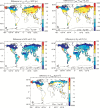Dominant control of temperature on (sub-)tropical soil carbon turnover
- PMID: 40374595
- PMCID: PMC12081612
- DOI: 10.1038/s41467-025-59013-9
Dominant control of temperature on (sub-)tropical soil carbon turnover
Abstract
Carbon storage in soils is important in regulating atmospheric carbon dioxide (CO2). However, the sensitivity of the soil-carbon turnover time (τsoil) to temperature and hydrology forcing is not fully understood. Here, we use radiocarbon dating of plant-derived lipids in conjunction with reconstructions of temperature and rainfall from an eastern Mediterranean sediment core receiving terrigenous material from the Nile River watershed to investigate τsoilin subtropical and tropical areas during the last 18,000 years. We find that τsoil was reduced by an order of magnitude over the last deglaciation and that temperature was the major driver of these changes while the impact of hydroclimate was relatively small. We conclude that increased CO2 efflux from soils into the atmosphere constituted a positive feedback to global warming. However, simulated glacial-to-interglacial changes in a dynamic global vegetation model underestimate our data-based reconstructions of soil-carbon turnover times suggesting that this climate feedback is underestimated.
© 2025. The Author(s).
Conflict of interest statement
Competing interests: The authors declare no competing interests.
Figures





References
-
- Lal, R. Soil carbon sequestration impact on global climate change and food security. Science304, 1623–1627 (2004). - PubMed
-
- Crisp, D. et al. How well do we understand the land-ocean-atmosphere carbon cycle? Rev. Geophys.60, 1–64 (2022).
-
- Wang, S. et al. Soil and vegetation carbon turnover times from tropical to boreal forests. Funct. Ecol.32, 71–82 (2018).
-
- Carvalhais, N. et al. Global covariation of carbon turnover times with climate in terrestrial ecosystems. Nature514, 213–217 (2014). - PubMed
-
- Davidson, E. A. & Janssens, I. A. Temperature sensitivity of soil carbon decomposition and feedbacks to climate change. Nature440, 165–173 (2006). - PubMed
Grants and funding
LinkOut - more resources
Full Text Sources

